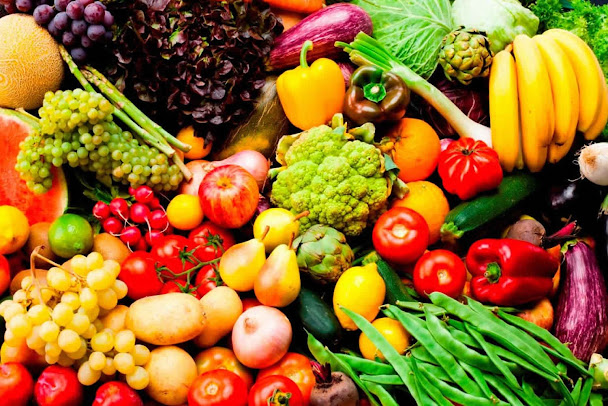“SORRY, THERE’S NO MAGIC BULLET. YOU GOTTA EAT HEALTHY AND LIVE HEALTHY TO BE HEALTHY AND LOOK HEALTHY. END OF STORY.” – MORGAN SPURLOCK, DOCUMENTARIAN, FILMMAKER AND PRODUCER
Your lifestyle decisions have an effect on your health. This is particularly valid for the meals you consume. Particular diseases can be prevented or brought on by eating certain foods or not eating them. There is always potential to improve your health through nutrition, even if you have a history of consuming bad meals. Just keep in mind that making changes like these might take time, and discovering your ideal diet won't happen quickly.
The secret to healthy eating is to choose a variety of real
foods over processed ones, such as fruits and vegetables. Focus on assembling
these entire meals into a bright and varied platter. The variety is preferable
to trying to consume a lot of just one kind of meal or vegetable. Eat the
following foods as part of your diet.
You get fibre from whole grains, which helps you keep your
blood pressure steady. This nourishes your body generally and lowers your risk
of diabetes, heart disease, and other heart-related conditions.
Other nutrients and health advantages that whole grains
provide include:
• The B vitamins Whole grains include a variety of vitamins,
including thiamine, riboflavin, and niacin. They help the body process protein,
fat, and carbohydrate energy. B vitamins are also necessary for your
neurological system to work as effectively as possible.
• Iron. Iron's primary function is to facilitate the blood's
transportation of oxygen. There are two forms of iron; one is heme-iron, which
is derived from meat. Non-heme iron is a different form of iron that is also
present. The latter is one of the main sources of non-heme iron and is present
in whole grains and whole grains that have been fortified.
• Selenium and magnesium. Magnesium gives the muscles energy and aids in bone development. Your cells' oxidation is reduced by selenium. These two minerals are essential for the health of your immune system.
One of the most important ways to lower your cholesterol levels is to limit the quantity of fat you consume. You are more likely to develop coronary artery disease and are at risk for heart attack and stroke if you have high cholesterol levels. Numerous meat varieties have significant fat content, and consuming a lot of meat is frequently the main factor raising cholesterol levels. Consider including these protein sources to get the protein in a healthy way:
• Skinless chicken, skinless fish, low-fat dairy products, eggs, beans, soy products, and lean ground beef
Monounsaturated and Polyunsaturated Fats
To survive, your body requires fats. Your body needs fat for
vital nutrients, vitamins, and energy. Additionally, it aids in the creation of
the nerves that surround each cell as well as the outside of every cell in your
body.
Without fat, you won't be able to move your muscles, prevent
blood clots, or reduce inflammation. For the control and prevention of disease,
each of these tasks are essential.
Olive oil, canola oil, vegetable and nut oils, margarine,
nuts, seeds, and avocados are just a few examples of fat foods you need
Know this and grow. Your natural
fluid balance, blood pressure, and blood volume are all out of balance when you
consume too much sodium. Additionally, consuming too much sodium makes your
lower extremities swell. Reducing your sodium intake lowers your risk of
developing heart disease and generally improves your resistance to disease.
These are some of the greens that do this: Mustard greens,
Kale, Bok choy, Spinach, and Kale.
Citrus Fruits
Essential elements like vitamin C, flavonoids, and fibre are present in citrus fruits. They support the digestive system, lower the chance of harmful cardiac events, and reduce inflammation. Citrus fruits provide numerous health advantages, including the ability to prevent diabetes, cancer, and neurological disorders.
Consider including citrus fruits like oranges, grapefruits,
tangerines, and blood oranges.
Root Vegetables
You can include root vegetables in your diet, such as
fennel, onions, celery root, ginger, turmeric, beets, carrots, parsnips, sweet
potatoes, yucca, potatoes, and yams.
Probiotics
There are both beneficial and bad microorganisms in your
body at all times. When the bad bacteria in your body outnumber the beneficial
ones, an illness results. Good bacteria are referred to as probiotics. In order
to effectively fight infections and support your body's digestive functions, it
is crucial to consume probiotic-rich foods or add them to your diet as
supplements.
Garlic includes antimicrobial substances that strengthen the
immune system and increase the production of virus-fighting cells. It also
lowers stress hormones and supports healthy immune system functioning. In
general, you should strive to eat a range of nourishing foods. In your effort
to prevent sickness, keep in mind that your diet should be considered as a
whole rather than just one particular meal.
DISCLAIMER; - The information on this blog stie is not intended or implied to be a substitute for professional medical advice, diagnosis, or treatment. All content including text, graphics, images and information, contained on or available through this blog site is for general information only. NEVER DISREGARD PROFESSIONAL MEDICAL ADVICE OR DELAY SEEKING MEDICAL TREATMENT BECAUSE OF SOMETHING YOU HAVE READ ON OR ACCESSED THROUGH THIS BLOG SITE













Comments
Post a Comment